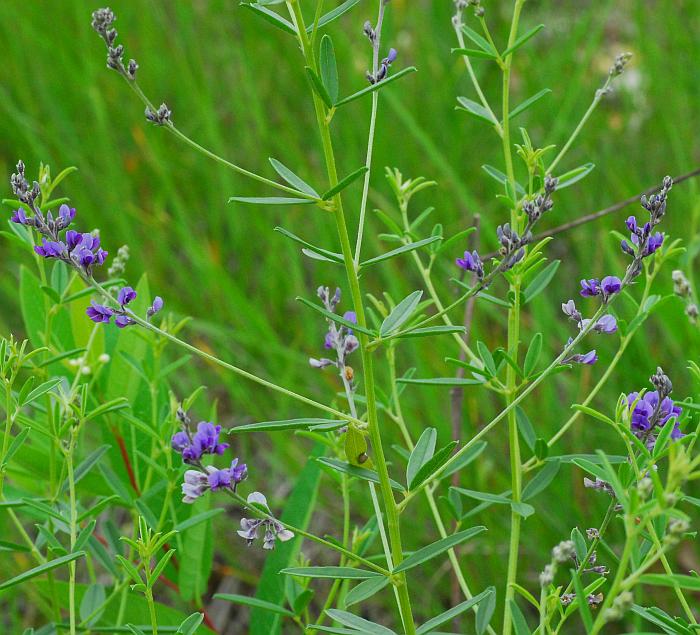Pediomelum tenuiflorum (Pursh) A.N. Egan
Gray Scurf Pea

Native
CC = 8
CW = 5
MOC = 54
© SRTurner
Pediomelum tenuiflorum (Pursh) A.N. EganGray Scurf Pea | |
 |
Native CC = 8 CW = 5 MOC = 54 |
© SRTurner |
|
Family - Fabaceae/Faboideae Habit - Perennial forb with a stout taproot below a thickened, often relatively long-branched caudex, not tuberous-thickened. Stems - Loosely ascending to erect, to 1.0 m, sometimes from a spreading base, well-branched above the base, moderately to densely pubescent with short, appressed to upward-curved, whitish hairs, sometimes only sparsely hairy toward the base or with scattered, longer, spreading hairs, sometimes sparsely gland-dotted, the lower few nodes often leafless (with the stipules fused). Hairs often mostly in distinct longitudinal lines with some sparse pubescence between the lines.
Leaves - Alternate, palmately 3-5-foliate (the uppermost leaves occasionally appearing simple), petiolate, stipulate. Petioles 0.2-3.0 cm long, the uppermost leaves sometimes nearly sessile. Stipules of well-developed leaves 2-5 mm long, linear, hairy, and gland-dotted. Leaflets 1.5-4.0 cm long, elliptic to oblanceolate, rarely obovate or nearly linear, rounded to bluntly pointed or shallowly notched at the tip, occasionally a few of the leaflets sharply pointed, the upper surface sparsely and minutely appressed-hairy to nearly glabrous, also densely gland-dotted, the undersurface moderately appressed-hairy and sparsely to moderately gland-dotted.
Inflorescences - Spikelike racemes with 2-4 often relatively crowded clusters, sometimes reduced to a solitary cluster, 1.5-6.0 cm long and 0.8-1.2 cm wide at flowering, elongating to 3-10 cm with age, the stalk 2-9 cm long, the bracts 2-3 mm long, lanceolate to ovate, angled or tapered at the tip, hairy and usually also gland-dotted, the flower stalks 1.5-3.0 mm long. Flowers 1-4 per node.
Flowers - Calyces uniformly woolly-hairy, 2.5-4.0 mm long at flowering, the tube 1-2 mm long, not pouched at the base, the upper lobes 0.5-1.0 mm long, the lowermost lobe 1.5-2.0 mm long. Corollas papilionaceous, 5-7 mm long, usually bluish purple to purple to nearly white, the banner sometimes with a pair of white spots toward the base and lighter purple on the outer surface. Stamens 10. Filaments with the fused portion 2.5-3.5 mm long, the free portion 0.5-1.0 mm long, the filaments somewhat broadened. Style 2.2 mm long, glabrous. Ovary 0.9 mm long, glabrous.
Fruits - Modified legumes with the body 5-7 mm long, 3-4 mm wide, elliptic in outline, glabrous, densely gland-dotted, tapered to a short, straight, triangular beak 1.5-2.0 mm long, the surfaces leathery, indehiscent (shed along with the calyx and flower stalk). Seeds 4-5 mm long.
Flowering - April - September. Habitat - Glades, upland prairies, streambanks, ledges and tops of bluffs, railroads, roadsides. Origin - Native to the U.S. Lookalikes - None. Other info. - This species is common in the upper 2/3 of Missouri, but uncommon or absent through much of the Ozark region. Missouri lies near the eastern edge of its natural range, which extends through a large portion of the central continental U.S. The plant is recognized by its long, narrow inflorescences of bean-pattern flowers which range from purple to nearly white in color, and its palmately compound leaves. The leaflets are narrow and usually somewhat shiny on the upper surface, and under close examination are seen to have dense glandular stippling. The plant has been cultivated for erosion control and for support of honyebees. Photographs taken at the Settles Ford Conservation Area, Cass County, MO., 7-14-00 (DETenaglia); also at St. Joe State Park, St. Francois County, MO, 6-2-2013, Valley View Glade Natural Area, Jefferson County, MO, 6-1-2020, and Shaw Nature Reserve, Franklin County, MO, 6-12-2023 and 6-30-2023 (SRTurner). |